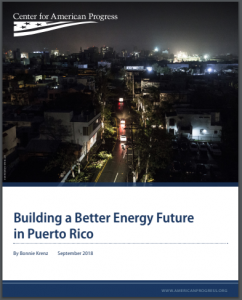Full Title: Building a Better Energy Future in Puerto Rico
Author(s): Bonnie Krenz
Publisher(s): Center for American Progress
Publication Date: September 1, 2018
Full Text: Download Resource
Description (excerpt):
In September 2017, Puerto Rico’s electricity grid was devastated by Hurricane Maria. Eleven months later, the commonwealth finally reconnected electricity for all of its residents. It was the longest, largest blackout in U.S. history and among the largest blackouts in the world. The island’s sole electric utility—the vertically integrated, government-run Puerto Rico Electric Power Authority (PREPA)—faced numerous challenges even before the storm. With most of Puerto Rico’s grid powered by expensive, imported fossil fuels, including 47 percent of electricity generation coming from petroleum, the cost of residential electricity in Puerto Rico is higher than it is in most states. At the same time, the median household income on the island is less than half the median household income in Mississippi, the poorest of the 50 states. PREPA has more generation capacity than it needs to power the island today, but it is largely in the form of legacy fossil fuel plants, which are both expensive to maintain and not well-suited to meet the island’s energy needs and goals. Puerto Rico passed a renewable portfolio standard (RPS) in 2010, requiring PREPA to generate 12 percent of its electricity from renewable sources by 2015, 15 percent by 2020, and 20 percent by 2035—goals that the commonwealth has so far failed to meet. Currently, just 4 percent of electricity in Puerto Rico is supplied by renewable energy sources.
